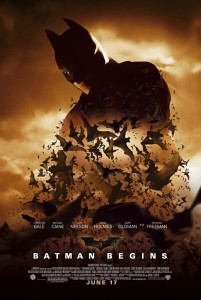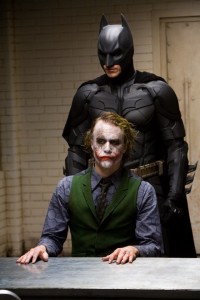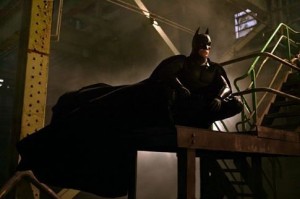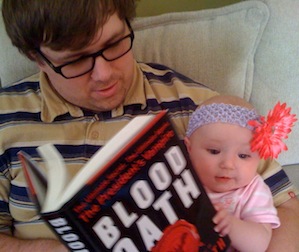Batman on Film: Christopher Nolan Resurrects the Dark Knight

While Burton touched on a bit of Batman’s origin in his 1989 film, we never really got a full-blown origin story until Batman Begins. We’re so used to Bruce Wayne, the millionaire playboy, it was refreshing to see a conflicted, angry, and aggressive young Wayne on his quest for vengeance. This is a side of Bruce I’ve wanted to see in the movies and Christian Bale was perfect casting to portray the edgier side of Bruce Wayne. In fact, after the ultra-camp of Batman & Robin, I was ready for a film that went in the opposite direction and Nolan’s first two films did this. After watching them several times throughout the last few years, it’s clear that Nolan wanted a Batman film that could be plausible in the real world. That’s why we never got any of Batman’s more outlandish members of the Rogue’s Gallery. Even though there are several villains I would love to see on the big screen, they wouldn’t fit the tone and feel of the Nolan films. Nolan’s films play off more as realistic crime dramas ala Heat more than they play as legitimate superhero flicks, which in my mind makes them special. It was also a bold move to reboot a franchise on the strength of the Scarecrow and Ra’s Al Ghul as its main villains. Doing so really let Nolan focus on the birth of the Batman character, especially with the opening sequences involving the League of Shadows. Even though he’s filled with rage and anger, Bale’s Bruce Wayne is unable to cross over enough to break his moral compass. Bend perhaps, but never break (it’s a trait that endures even when Joker does his best to break Batman’s spirit in The Dark Knight).
Another fun little intricacy I noticed between Batman Begins and The Dark Knight involves Scarecrow. In the first film, Scarecrow is a rather formidable opponent for Batman. As a hero, Bats is still pretty green when he first faces off with Scarecrow. I think at that time, most of his fighting was clouded by his desire for revenge. Even though he was fighting criminals, his ultimate goals all centered on taking the mob down because they were ultimately responsible for the death of his parents. Once he was forced to assume the hero role, Batman was able to defeat Scarecrow. Now, in The Dark Knight, Nolan deliberately has Batman dispose of Scarecrow pretty handedly in the film’s first fight sequence to not only show how strong Batman was now, but also how he’s grown as a hero. This little sequence lets the audience know we’re about to witness a different Batman. Which, after you finish The Dark Knight and see the path of destruction Heath Ledger’s Joker left behind, is a good thing.

Christian Bale and Heath Ledger in “The Dark Knight.” © TM &DC Comics.2008 Warner Bros. Entertainment Inc. All Rights Reserved.
Since I mentioned Ledger, let’s dig right in to the nitty gritty of his performance of the Joker. To put it bluntly, this is the performance that epitomizes what I see in the Joker as a character. Sure, I’ve loved most of the interpretations of the character in the movies and comics, but until someone outperforms Ledger, when I think of the Joker, I will see his face. It’s just an absolute shame he isn’t around to witness the fruits of his labor because he would be proud. He describes himself in The Dark Knight as an agent of chaos and as a dog who just wants to chase cars. That manic attitude really shines through in all the actions and little ticks and quirks Joker has. You’re never quite comfortable when the Joker is on the screen because of that uncertainty. When he’s being funny, the laughs come out almost uncomfortable. He’s a creepy and dark character who really fits into Nolan’s bleak portrayal of the world of Gotham City. His posthumous Oscar was well-deserved.
While Batman is busy fighting Scarecrow, Ra’s, and the Joker, he’s also hard at work ridding Gotham of organized crime. The mob aspects of Nolan’s films feel heavily inspired by some of Frank Miller’s work on the Batman comic. Having one of the main antagonistic sub-plots focusing on organized crime really helps ground the franchise in reality. The actors they have playing the mob bosses (especially Eric Roberts) are top notch in their roles as wise guys. I really like the unification between the super world and the real world, so having Scarecrow work with Falcone (the amazing Tom Wilkinson) and Maroni teaming up with Joker and all the organized crime in the city to take down Batman are just two really great plots.

Christian Bale in “Batman Begins.” © 2005 Warner Brothers. All rights reserved.
Another motif Nolan touches on in his Batman films is the notion of wearing masks. Bruce Wayne has a physical and psychological mask to wear. There’s ultimately an inner turmoil going on with him regarding his role as Batman as well. On one hand, he’s stopping crime, but is he doing it because it’s the right thing to do, or because it’s a release for all his rage over the death of his parents? In The Dark Knight, Wayne hopes to be able to retire the mask in favor of his “White Knight” counterpart, Harvey Dent (Aaron Eckhart). When Joker sets up the explosive trap for Dent and Rachel (Maggie Gyllenhaal), he essentially causes Dent to change his mask from justice to vengeance. There are a lot of things that happen out of the ordinary because of the Joker’s plans. Everything from faking a death to stooping to his level is implemented to stop him. Even Joker himself seems to be wearing a mask underneath that smudged face paint. Joker is never truly honest with his victims, telling them conflicting scar origin stories. For someone who wants Batman to break all the rules, Joker sure does mask some of his deeper secrets. In fact, the audience never gets a clear Joker origin, which just adds to the discomfort (in a good way) created by the character.
I hope you all enjoyed my four-week journey through the Batman live-action films. It was fun going through all the movies in preparation for the finale of Nolan’s trilogy. I’ll touch on The Dark Knight Rises later on this week when I review the film. It’s safe to say that I’m feeling a little bittersweet about this chapter in the Batman universe coming to a close. Christopher Nolan, Christian Bale, Gary Oldman, Michael Caine, and Heath Ledger have left tremendous shoes to fill (and I’m guessing I can add Tom Hardy and Anne Hathaway to this list later this week). Even though they say all good things must come to an end, that doesn’t always make it an easy pill to swallow.
Check out the other Batman on Film articles here!
Batman (1966)
Tim Burton Brings the Dark Knight to the Modern Cinema
Joel Schumacher Almost Kills the Batman Franchise


Latest posts by Dane Jackson (see all)
- Five Christmas Movies That Should Be Part of Your Holiday Tradition - December 18, 2015
- San Diego Comic Con Lifts Batman v Superman above the Horizon - July 17, 2015
- Interview with Hollywood Legend Marion Ross, Star of A Reason - January 11, 2015


